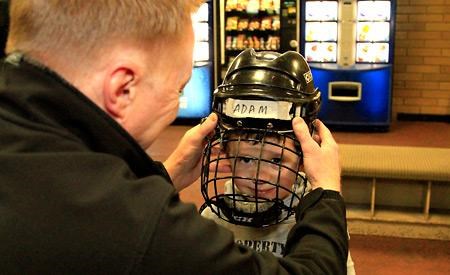No definitive assessment, no foolproof treatment and no equipment can guarantee prevention of concussions in hockey. What’s happening currently is a raging debate on rules, equipment, speed, size, facilities, penalties and suspensions. Everyone has an opinion.
Former coach of Victoria Cougars and Powell River Kings Rick Hopper’s concern for the game today is, “the lack of respect that the kids have for each other. Years ago you would go out there and really want to hurt somebody,” he said, “but that’s the thing that needs to be driven from the game.”
BC Hockey League commissioner John Grisdale wants to do that through the supplementary discipline program and the rule book but he adds, “The game was set in place with bodychecking and the intent to separate the puck from the player. It’s a physical game.”
Often the physical game turns to fighting and that, said Kings’ Dr. Steyn Naude, “has to go.”
“You will still see a certain percentage of Kings’ fans who want to see a fight,” Grisdale countered, “but there is a growing number who are okay with the occasional one and that’s a change from a few years ago.”
Kings’ trainer Pat Hurren recommends a combination of some rule changes and equipment changes such as elbow pads going back to leather. “Look at the guys who are playing now. You’ve got a six-foot, six-inch 230-pound moose barrelling down on you,” he said, “so for a 150-pounder that’s going to hurt.”
When asked what he would do, his partner trainer Brandon Kerr shot back, “You have to eliminate head shots altogether and you do that with bigger suspensions and fining teams.”
Their boss and Kings’ head coach Kent Lewis said he suffered several concussions including one in junior hockey. He remembers playing a home game in Nanaimo and “when I left the game I went into the opponents’ dressing room.”
His concussion claim to fame was in the Western Hockey League when he had a head-on collision with former Toronto Maple Leaf and Hall of Famer Wendall Clark.
That was a one-on-one collision which is acceptable to Lewis. “If a player is engaged with another player in a physical battle then nobody else should be able to run at him. That would eliminate a lot of things.”
Former King Bobby Tyson spoke of subtle but important rule changes. “I took a lot of pride holding up the oncoming forechecker for my D-partner so that he didn’t get crunched behind the net. Now you’ve got a guy going back there and he’s a sitting duck.”
Powell River Regals veteran Bob Crawford cannot count the number of concussions he might have suffered because they never even treated them that way. “I remember getting hit with a clean hit but my helmet was on backwards,” he said. “I saw stars and I just barely got off the ice on my own because in those days not too many guys laid on the ice. Smelling salts were gross. It usually cleared your head because you didn’t want to get them again.”
Asked about his thoughts to address concussion injuries he said, “You don’t need this jet-age plastic equipment because you get hit with that kind of stuff and it’s got no give. The only thing that’s going to give is your head.”
That’s a well-documented fact but until the sport catches up to the science and the science catches up to the injury, Naude and other physicians urge everyone to educate themselves as the best prevention.
“What we are doing right is consciously thinking about the injury,” he said. “We’re recognizing it a little bit better and there is better player and coaching education. What can we do even better?” he asked. “More education, a lot more education.”
All hockey associations in BC have banned bodychecking for house league hockey because studies have shown it leads to increased injuries, including concussions.
It seems that the federal government is ready to help with the announcement on January 19 of $1.5 million for ThinkFirst Canada, Hockey Canada, the Coaches Association of Canada and the Canadian Centre for Ethics in Sport.
These groups will work on increasing awareness of the concussion problem among coaches, players and parents.
“We want our children to be healthy, active and to have fun while participating in team sports and physical activity,” said Bal Gosal, federal minister of state for sports, “but we also want our children to be safe.”
This is the final in a five-part series on concussions in hockey.



